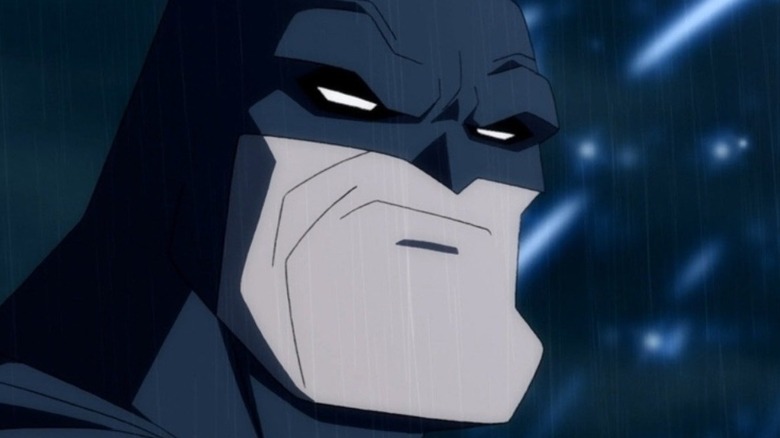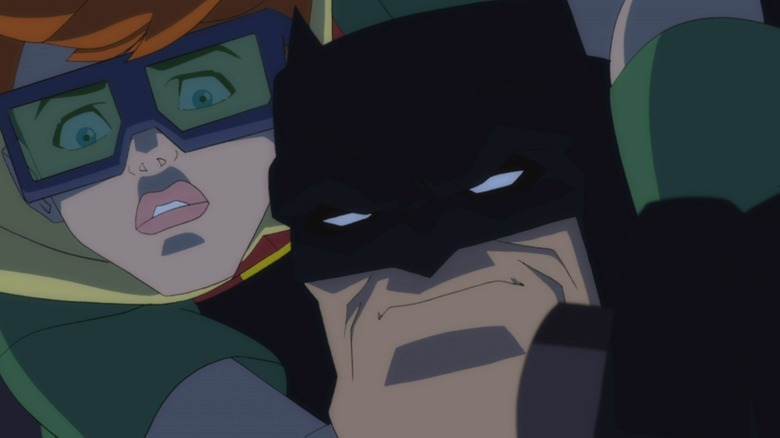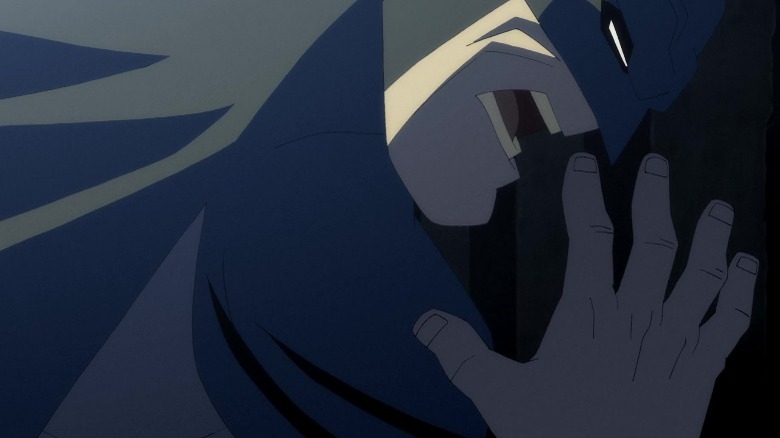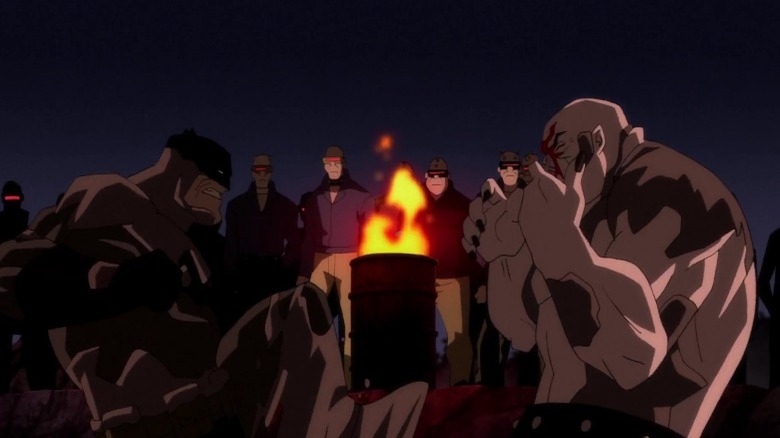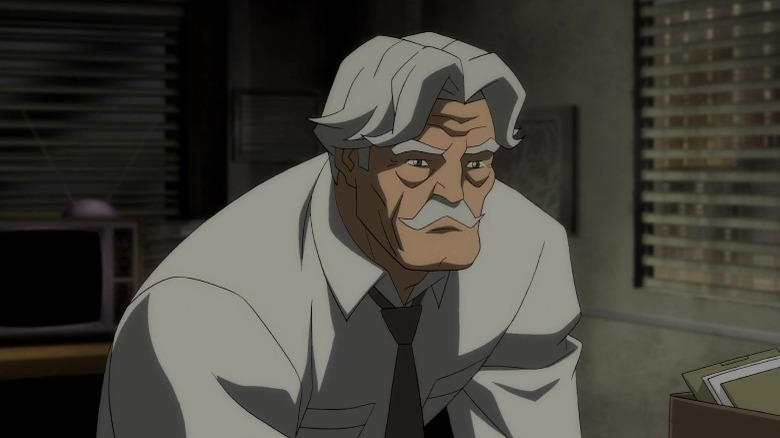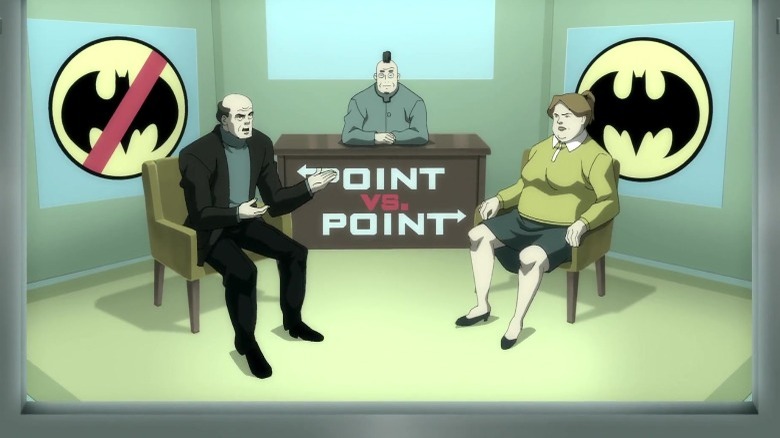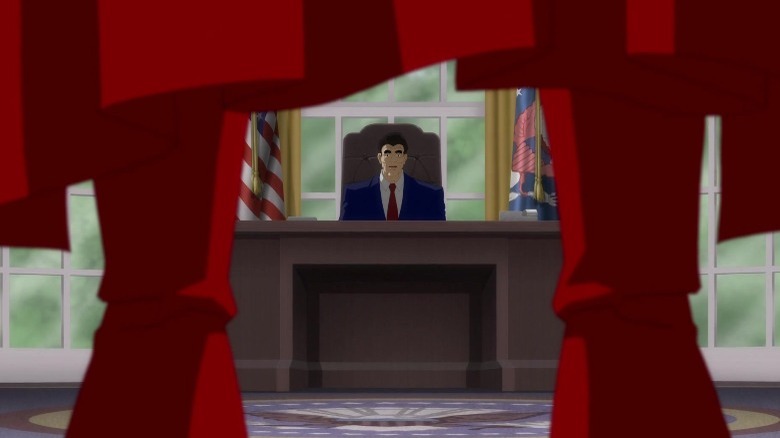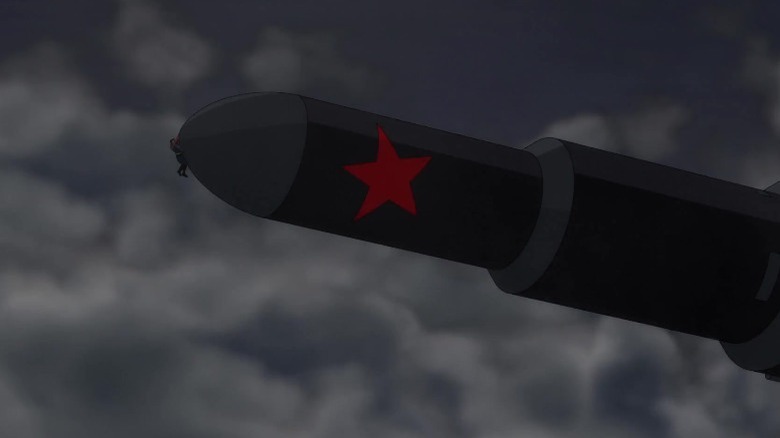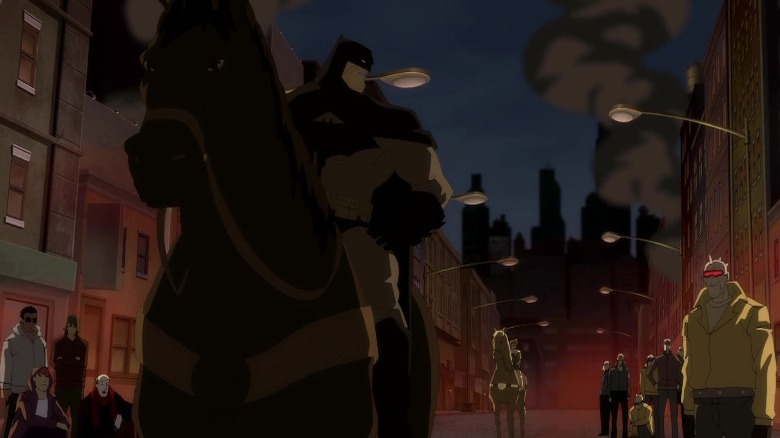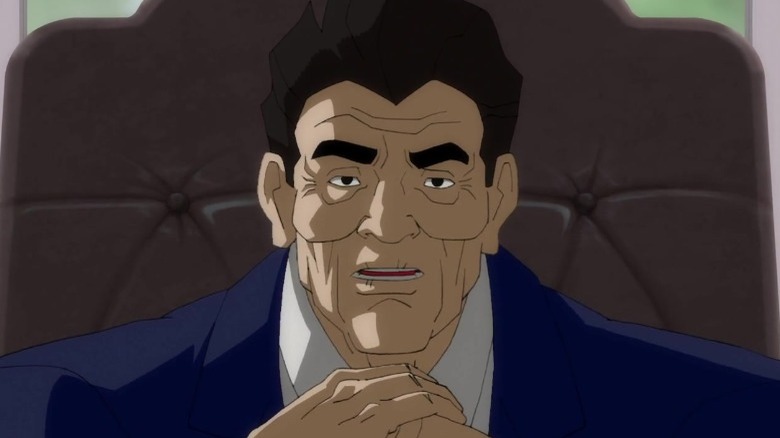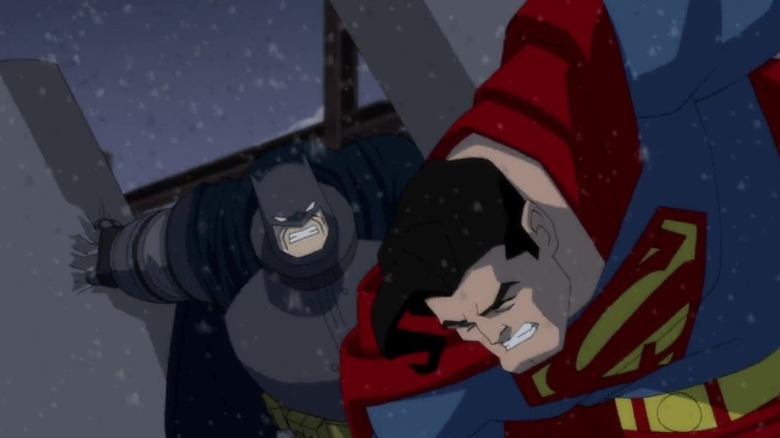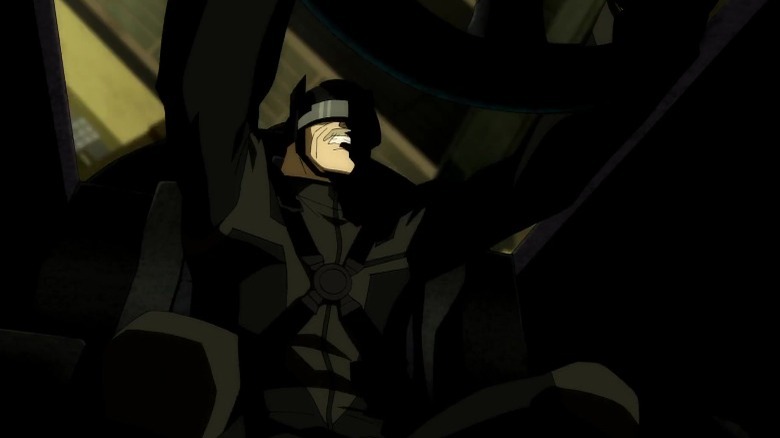The Ending Of 2013's Batman: The Dark Knight Returns Explained
Broken, beaten, and bleeding — it's a learning moment for the Dark Knight (Peter Weller). He longs for a good death, but one at the hands of a childish gang leader is far from acceptable. In 2013, the "Batman: The Dark Knight Returns" animated film adapted one of the most time-honored and beloved Batman stories of all time. Writer and illustrator Frank Miller crafted one of the most provocative and revolutionary Batman tales in comic book history. In fact, Miller's 1986 graphic novel of the same name is often credited by fans with ushering in an era of adult-centric narratives that gave way to grittier takes on the world's best-known heroes.
Bruce Wayne had given up the cowl a decade ago. But as the story of "The Dark Knight Returns" unfolds, we learn that was never something he wanted to do. Now, he is back with a vengeance. His ferocity is only amplified by his guilt for leaving Gotham without a protector for 10 years. Batman is now delivering crippling punishments to the criminals of Gotham. As a new police commissioner takes charge and directs the entire force at the Caped Crusader, Batman is tasked with preventing the Mutant gang, Two-Face, and Joker from spilling blood on the streets of Gotham. With Superman (Mark Valley) now a government lackey, Batman finds himself at odds with the Big Blue Boy Scout since his return threatens the perception of total government control. There are a lot of heavy themes at play in "The Dark Knight Returns," so strap in for an analysis of the film and its concluding implications.
Burgeoning guilt
Little history is given behind Batman's decision to retire, though, through some dialogue with Superman, we can glean that perhaps it wasn't entirely Bruce's decision. In this world, heroes have largely been disbanded. Wonder Woman returned to Themyscira. Hal Jordan (Green Lantern) left the planet. And Superman is now loyal to the U.S. government. It seems that heroes weren't something the government could control, so they forced them to retire. Bruce's temperament shows that he's bitter in his old age, but it's not his age that made him so. It's the simple fact that he went back on a promise he made to himself as a young boy to stand up for the city in the wake of his parents' death.
Bruce is partially motivated by guilt over his sudden retirement. We also see the regret he feels any time Alfred brings up the death of Jason Todd, the second Robin to don the Boy Wonder costume. Despite the death of the youngster, this doesn't stop Batman from taking on a new protégé in the form of Carrie Kelly. This time, however, he provides her with explicit instructions meant to keep her out of harm's way. Of course, she never really adheres to the protocol as she is always looking out for Batman and lending him a hand when he needs it. When she succeeds, Batman remarks, "good soldier," It's an effort to grant her the praise that he never got to share with Jason before his untimely death. While guilt isn't everything, it's most certainly a driving factor in Bruce's return to the cowl.
A more unforgiving Batman
There's a potent concoction swirling beneath the exterior of Bruce's hardened surface. It's a combination of rage, bitterness, and the guilt we already discussed that ultimately manifests as a really bad time for criminals. As a vigilante, Batman is known for using fear as a tactic to spread his influence among the criminal empires of Gotham. He doesn't kill, but he has no problem doling out punishment. However, the much older Batman has embraced the symbol of fear. His brutality exceeds what we traditionally see from the Dark Knight, even to ordinary criminals. In his first moments back as the Dark Knight, he cripples a man. During fights with multiple criminals at once, some die as a result of indirect collateral damage such as when Batman knocks over a mutant that drops a live grenade and explodes. Batman doesn't outright kill, but he also doesn't seem as concerned with saving criminals from death. When he finally combats the mutant leader, Batman breaks his arms and legs in a humiliating takedown.
Later, when Batman confronts the Joker, he verbally acknowledges his regret for not killing the Joker earlier in his career. Batman feels the sting of remorse for all the people he feels that he has murdered by proxy for letting the Joker live. The Dark Knight brutalizes the Joker throwing a Batarang clean through his eye before pummeling the madman nearly to death. Then, in a fit of rage, he breaks the Joker's neck. While he steps right up to the line, he barely manages to not cross it. Yet, Joker finishes the job by twisting his neck the rest of the way to make it look like Batman murdered him.
The lesson of the Mutants
The Mutant leader seems to be all talk and bluster appearing over Gotham's airwaves threatening carnage and violence. Bruce's first major confrontation since his return as the Caped Crusader proves to be a nearly fatal one. He attempts to fight the Mutant leader just so "he'll know." Know what, you might ask? Well, he's got to know where he stands physically. Being out of the game for a decade can really change things. So, of course, Batman wants to test his might against one of the most feared criminals Gotham has seen in a long time. The Mutant leader nearly kills Batman. If it weren't for Carrie Kelly, the Dark Knight's story might end during that brawl among the landfills of Gotham.
Bruce doesn't doubt his abilities after recovering from the fight. He just understands that he has to fight differently. As an older man, he doesn't have the energy that he used to have. He can't simply focus his aggression on his opponents to beat them into submission. Bruce realizes that he has to be smart about his movements. He later takes down the Mutant leader in a brutal display by outsmarting him and leaning heavier on defense. He enacts tactics such as slicing the kingpin above the eyebrow so that blood would pour into his eyes. This new way of operating isn't just a one-and-done ordeal. He adopts this approach throughout the remainder of the film including in his final confrontation with Superman.
The spirit of the law
The film presents two commissioners each with opposing ideas on the emergence of Batman once again in Gotham. Commissioner James Gordon (David Selby) knows Batman well, and at this stage, he is even aware of Batman's identity as Bruce Wayne. Ellen Yindel (Maria Canals-Barrera) is set to replace Jim as his tenure ends during the film. She adamantly states that she abides by the letter of the law and deems Batman a criminal who has brutalized criminals and must be detained. When she asks Jim how he could condone Batman's actions all of these years, he explains that some things are simply bigger than our opinions and judgments. He realized there are limitations to everything he can do as a cop, but Batman is capable of going beyond those boundaries.
And make no mistake, Batman doesn't consider himself an upstanding citizen in this narrative. Bruce even admits to Clark that they're both criminals. He knows that what he does is illegal, but that doesn't change the fact that he still believes in the mission and the end result. Jim is a good cop, but letting a perceived criminal continue to dish out punishment on the streets of Gotham is something he sees as living the "spirit" of the law, a compromise he's willing to make to keep the city safe.
Everyone's a critic
You might wonder what it'd be like if a vigilante like Batman actually existed. And when we say "like Batman," that means he's a successful crime fighter capable of evading the law, not just some Joe Schmoe off the street whose fight with a thug winds up on YouTube. There would, of course, be a public discourse on the existence of such a figure. And just like every topic, there are two (or more) sides to everything. "The Dark Knight Returns" depicts the public's reaction to Batman's return and debates the merits of his crusade.
There are those who champion social order and demand Batman's arrest, while others, like Lana Lang (Paget Brewster), get behind the idea that what he's doing is morally just since the police force can't seem to grapple with the growing crime wave themselves. The differing opinions in moral philosophy stand as a marked contrast among the public.
The Kryptonian lapdog
Superman isn't the bright and shining hero we once knew in this story. The superheroes have been beaten by government regulations. Despite his infinite power, Superman submits to the U.S. government and follows the president's orders. One might assume, perhaps, that crooked politicians or military figureheads have some sort of dirt or weapon they can wield against Superman in order to coerce his allegiance. However, it doesn't seem that is the case as Superman defies the principles he used to stand for. Characteristically, it seems there's been a shift in his worldview.
When the President says go to Corto Maltese and aid the U.S. troops on the ground, that's exactly what Superman does. We can see him demolishing Russian jet fighters and tanks with little care for the lives aboard each craft. Clearly, he's not against enforcing the president's will. The narrative implies that he took Oliver Queen's arm during a skirmish since the Emerald Archer was one of the few DC heroes to disagree with the move to dissolve the Justice League. Superman even puts killing Bruce Wayne on the table should Bruce force his hand. Somehow, the federal government has corrupted our beloved Kryptonian hero. Even though he dons the Superman outfit, he's never once referred to as "Superman" in this story, which is an indication in itself that he isn't the hero he once was.
The Cold War
Set during the height of the Cold War, the Soviet Union and the United States are at odds over the fictional island nation of Corto Maltese. While this event mostly plays out as a news headline, it all comes to head when the U.S. armed forces on the ground take control of Corto Maltese thanks to Superman. As President Ronald Reagan cheekily states, those Soviets are a bunch of sore losers as they send a parting gift in the form of a nuclear warhead to the U.S. mainland. This moment played off the very real fears of the era in which Frank Miller's comic in 1986 was released. The Soviet Union and the United States could enter into a nuclear conflict at any point given the tension between the two superpowers.
President Reagan claims that the U.S. has God on its side — or at least the "next best thing." Superman swoops in to divert the missile into the atmosphere saving countless lives and potentially staving off a retaliatory attack from the U.S., which would've plunged the world into a nuclear holocaust. Still, the explosion of the missile in the Earth's stratosphere results in an EMP (electromagnetic pulse) that wipes out all electronics across Gotham (and likely many other parts of the country). This sets the stage for Batman to truly reclaim his status as an icon within Gotham as chaos breaks out in the streets.
The power of the people
Amid the burgeoning chaos within Gotham City, Batman takes control and maintains order. Many years ago, the Caped Crusader showed an entire city what one man could do who committed to standing up against the seedy underbelly of the city he called home. Now, amid the darkened corners of the city following a blackout after a Russian nuclear missile is detonated in the stratosphere, Batman commands with authority. The chaos is overwhelming the police force. It's at this time that Commissioner Yindel realizes the truth of what Jim's parting words with her were; Batman is simply bigger than she realized.
With his influence, he puts the power to save the city in the hands of the people. He convinces them that they must help police their streets, homes, and neighborhoods to ensure they stay safe and that everyone has the supplies they need to get by during trying times. The idea here is that when working together, ordinary people can affect change and have a lasting impact. Through Batman's example after a lengthy career of battling the hardened criminals of the city, citizens are inspired to at least do their part when calamity strikes.
Why Batman is a threat to the president
So, Batman dons the costume once again and begins taking down the criminal element once again. What's the big deal? Why is the president so distraught by Batman's return? Just like in the real world, everything in politics is about appearances. Batman's work becomes an embarrassment to the administration by showing citizens that a man who was never elected is managing to make progress like no other politician ever could.
Additionally, it flies in the face of the government-sanctioned takedown of superheroes. Superheroes no longer exist. Superman is much less a superhero and more of a weapon used against nations that threaten American interests. The costume is meaningless. Batman deciding to re-enter the spotlight despite his forced retirement demonstrates a rebellion against government regulations. The president doesn't care that Batman ended the mutant gang's bloody campaign or that he managed to maintain order in Gotham during the city's most trying moment. The only concern here is that Batman harms the image of elected leaders in place and must be seen as being in full control for the sake of appearances. It's a slimy thought, but one that is an actual reality despite the lack of real-world superheroes.
Batman versus Superman
The crowning moment of "The Dark Knight Returns" is Batman's battle with Superman. This fight would solidify Batman as a true contender in the world of DC heroes. Given careful planning and strategy, Batman surprises even Superman with his keen ability to assault the Kryptonian's senses with weapons such as a gun emitting sonic blasts, knocking him out of the sky with tracking missiles and subjecting him to electric shock merely as a distraction for the ultimate prize: a kryptonite-infused arrow delivered by Oliver. Batman tells Superman that his puppeteer masters sent the Man of Steel simply because they are an authority than can't stomach Batman being able to do what they can't. Superman, on the other hand, states it's "their world" and that Batman should sit down and accept it.
In the grand scheme of things, Batman and Superman's fight is a clashing of ideals. Batman represents the triumph of ordinary citizens who champion humanitarian causes and can effectively organize and regulate their own municipalities through civic leadership. Superman stands for government control and regulation, the complete opposite of his former philosophies. In effect, the nuclear launch was actually a result of Superman's provocation at the behest of the president. Superman destroyed the Soviet armies leading them to retaliate in a big, bad way. There's most certainly a critique here when it comes to the meddling of political leaders in the matter of civil and foreign affairs.
The metaphor of the opening race for Bruce's crusade
The beginning of the film starts off with Bruce amid a high-speed race on a drag strip. His internal monologue notes that he seeks a good death, but dying in a fiery blaze amid a car crash isn't good enough. It's clear that he seeks to fill the void of his long-lost career as Batman. After taking a massive tumble that ends in a wild explosion, spectators are almost sure they just witnessed the death of Bruce Wayne live. Moments later, it's revealed that he bailed out of the vehicle at the last moment and lives to see another day.
If you pay careful attention to the sequence, it becomes easy to see how this moment is actually a brilliant metaphor for Batman's journey in this story. Just as a race begins, Bruce gets back in the game and begins picking up speed exponentially with each new confrontation. Quickly, he goes from fighting ordinary thugs to confronting the Mutant Leader that nearly kills him. He also then clashes with Harvey Dent and the Joker in intensely dark scenarios. The escalation in his crusade culminates when Batman takes control of Gotham amid the blackout despite the President's foot soldier, Superman, warning him to stand down. Ready for the fight of his life, he clashes with the Kryptonian and successfully defeats him due to careful planning. Clark couldn't beat him, so there wasn't a good enough death in the fight despite feigning a heart attack. He finished what he had started and bailed living to see a new day, much like the calamitous crash at the beginning of the film.
